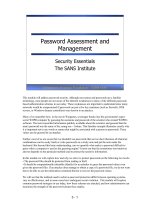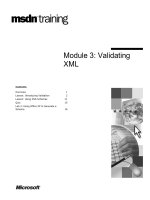Tài liệu Module 4: Risk Management ppt
Bạn đang xem bản rút gọn của tài liệu. Xem và tải ngay bản đầy đủ của tài liệu tại đây (257.45 KB, 34 trang )
Module 4: Risk Management
4
THIS PAGE LEFT INTENTIONALLY BLANK
0RGXOH#7=#5LVN#0DQDJHPHQW##7²6
2EMHFWLYHV
At the end of this module, you will be able to
„
Understand risk and why managing it is important
„
Understand the MSF proactive risk management
process
„
Understand the differences between risk mitigation
and risk contingency
„
Demonstrate the ability to do risk assessment
7²7# # 0RGXOH#7=#5LVN#0DQDJHPHQW
/HVVRQV
Lessons
1. Risk Fundamentals
2. Risk Management Overview
3. Risk Identification and Analysis
4. Risk Planning
5. Risk Tracking and Control
0RGXOH#7=#5LVN#0DQDJHPHQW##7²8
/HVVRQ#4=#5LVN#)XQGDPHQWDOV
Lesson 1:
Risk Fundamentals
The elements of risk and the
presence of risk in any project
7²9# # 0RGXOH#7=#5LVN#0DQDJHPHQW
5LVN
„
Definitions
„
Dictionary: “Possibility of loss
or injury”
Webster’s Collegiate Dictionary,
10th edition
„
Common: A problem waiting to happen
„
Characteristics
„
Inherent in every project
„
Neither intrinsically good nor bad
„
Not something to fear, but something
to manage
Risk is the possibility, not the certainty, of suffering a loss. The loss could be
anything from diminished quality of a solution to increased cost, missed
deadlines, or project failure.
Risk is a fundamental ingredient of opportunity and so is not inherently bad, but
it is inherent in every project. Successful teams deal with risk by recognizing
and minimizing uncertainty.
0RGXOH#7=#5LVN#0DQDJHPHQW##7²:
5LVN#6RXUFHV
Risks can come from many sources, including
„
Mission and goals
„
Decision drivers or organization management
„
Customers or end users
„
Budget, cost, schedule, and personnel
„
Project characteristics
„
Development process and environment
„
Operational environment
„
New technology
The subjects listed on this slide can be sources of risks, but they are not the
conditions or the consequences.
7²;# # 0RGXOH#7=#5LVN#0DQDJHPHQW
5LVN#,PSDFWV
Risk can affect a project in a variety of ways
„
Cost overruns and schedule slips
„
Inadequate functionality
„
Canceled projects
„
Sudden personnel changes or demoralized staff
„
Customer dissatisfaction
„
Damage to company image
„
Poor performance
„
Legal problems
Risk can affect a project in many different ways. This slide offers some typical
impacts of risk.
0RGXOH#7=#5LVN#0DQDJHPHQW##7²<
/HVVRQ#5=#5LVN#0DQDJHPHQW#2YHUYLHZ
Lesson 2:
Risk Management
Overview
The MSF approach to
risk management
7²43# # 0RGXOH#7=#5LVN#0DQDJHPHQW
$FWLYLW\=#0DQDJLQJ#5LVN
,Q#ODUJH/#LQVWUXFWRU0OHG#JURXS=#
Activity
Work together as if you are owners of a company
that is planning to build a warehouse. You’re
worried about your building catching fire. How will
you deal with that possibility?
0RGXOH#7=#5LVN#0DQDJHPHQW##7²44
6XFFHVVIXO#5LVN#0DQDJHPHQW
„
Assesses risks continuously throughout the
project life cycle
„
Uses risk-based decision-making
„
Establishes some level of formality
„
Covers all key persons and processes,
including business and technology areas
„
Treats risk identification as a positive
This slide lists a few of the characteristics typical of successful risk
management.
7²45# # 0RGXOH#7=#5LVN#0DQDJHPHQW
06)#5LVN#0DQDJHPHQW
Manage risk proactively
Proactive Reactive
Anticipate problems Fix problems when they occur
Address root causes Address symptoms of the
cause
Prevent and minimize risk React to consequences
through mitigation
Prepare for consequences React to a crisis
to minimize impact
Use a known and Use an ad hoc process
structured process
Risk management should be proactive, not reactive. It should continuously
assess what can go wrong and use that information for all project decision-
making. Proactive risk management requires a visible, measurable, and
repeatable process.
Preventing risk is the transition point between proactive and reactive risk
management.
0RGXOH#7=#5LVN#0DQDJHPHQW##7²46
5LVN#0DQDJHPHQW#6WUDWHJLHV
„
Reduce the risk
Example:
Minimize the probability
(likelihood of the condition)
Example:
Minimize the impact
(level of the consequence)
„
Transfer the risk
Example:
Move to different hardware
Example:
Subcontract to a third party
„
Avoid the risk
Example:
Don’t undertake certain projects
Example:
Rely on proven, not cutting-edge,
technology
Proactive risk management involves identifying risks ahead of time and
preventing them through reduction, transference, or avoidance.
„
Risk reduction tries to minimize the likelihood that a risk will occur (for
example, by building a warehouse out of fireproof materials) or to minimize
the impact (for example, by installing automatic sprinklers).
„
Risk transference tries to shift the risk to someone else (for example, by
contracting for fire safety with a third party).
„
Risk avoidance tries to eliminate the risk by doing something less risky (for
example, by building something less prone to fire than a warehouse).









